Menu
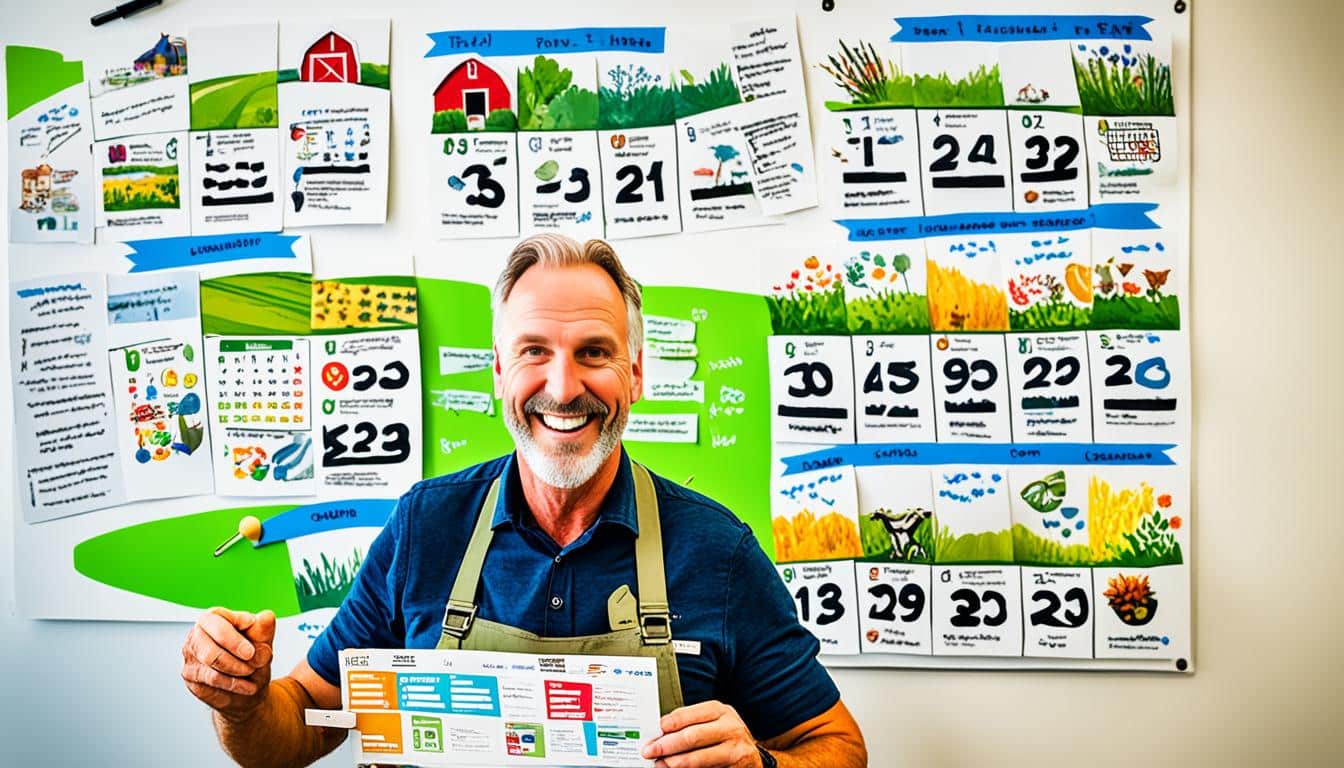
Did you know, 68 percent of adults in the US use Facebook? Also, 66 percent of them go on it every day. This is why managing social media well is crucial for farm marketing. Just like a crop plan for consistent harvests, a content calendar is vital. It keeps your posts from being all about selling, which can turn people away.
By telling stories and sharing useful information, you can build a bond with your followers. Valuable content helps in creating a welcoming online space for your potential customers. This, in turn, helps boost your sales when the time comes.
Social media isn’t just for ads. It’s for telling a story that connects with people. And it’s for making their time online better and more memorable.
For farm marketers, having a marketing calendar is key. It helps build a strong online community and attracts eager customers. This method makes sure your social media plans match the aim of keeping customers interested all year, not just when you’re selling.
A marketing calendar brings order to your social media tasks. Consider the winter of 2019. Farms got calendars with content ideas for November and December. These helped guide their social media plans. The calendars also gave tips on using images to communicate well.
Also, you can get help to plan, like the calendar template offered in June. It aids in scheduling posts. Having posts and graphics ready means you always have something to share. This keeps your farm’s online place fun and regular, helping build strong ties with your followers.
Keeping up a regular social media presence is key. It helps keep your audience interested even when you’re not selling directly. For instance, activities like fall conferences let you connect with people. And with resources like the Social Media Toolkit, making good content becomes easier. This means your marketing on social media is more effective.
A detailed marketing calendar keeps you active all year. It makes sure you engage regularly. Tools like holiday marketing calendars, often offered by groups like the Maryland Farmers Market Association, help make social media work well.
| Platform | Overall Usage | Ages 18-29 | Ages 30-49 | Ages 50-64 | Ages 65+ |
|---|---|---|---|---|---|
| YouTube | 73% | 91% | 87% | 70% | 38% |
| 69% | 79% | 79% | 68% | 46% | |
| 37% | 67% | 47% | 23% | 8% |
Knowing how people use social media can help you do better. It makes sure your posts connect with the people you want to reach.
A content calendar helps businesses plan and share social media content. It makes it easier to post regularly and at the right times. This way, your online presence looks polished and well-planned.

A good content calendar has important parts for social media success. It’s not just about posting; it’s about posting with a plan:
Using a content calendar boosts your farm’s online presence in many ways. It keeps your social media looking active and appealing:
For smart content calendar use, try management tools like Planoly, Hootsuite, or Facebook Business Suite. These let you plan and post ahead of time. They can really make your social media chores easier and more effective.
Getting a content calendar ready is key to a great social media strategy. It helps make sure your posts are always on time and hit the mark. Start by finding out the best times for big sales and promotions.
There are a few must-haves for your content calendar to work well in your social media strategy:
| Element | Description |
|---|---|
| Platforms | Decide on which sites to share your content (such as Instagram, Facebook). |
| Go-Live Dates | Set the specific days when posts should go out. |
| Post Captions | Write catchy captions for each post and platform. |
| Visual Format | Choose if the post will be a picture, video, or something else. |
| Links to Assets | Attach URLs for pictures, videos, and more. |
| Tracking Links | Include special tracking links for better analytics. |
Making content plans ahead makes everything better and easier. It’s proven to up the quality and lower stress. Tools like Later’s Draft Posts make teamwork smoother. They help everyone know what’s happening next.
Pre-planning with a content calendar lets you share posts several times, making them more visible. Sticking to a regular posting schedule is vital for success in social media in 2024. This has been proven by experts who’ve seen better interaction with fans.
For distant future plans, Asana is great, but for short-term actions, spreadsheets may be enough. Knowing what your fans like to see matters a lot. It makes sure your posts are just what they want, helping you reach your goals.
Keep a detailed content calendar to plan far ahead. Using a good scheduling tool makes this easy, linking your social media plans with your bigger aims. This way, you can track success clearly.
Choosing the right social media platforms for farm marketing means considering the audience’s interests and where they spend their time online. It’s also important to pick platforms where the farm can regularly share interesting content. Each platform has its own benefits, helping farms connect with more people in unique ways.
Facebook is the most popular social media platform globally. It’s great for businesses, like farms, with 68% of US adults and 66% daily users. Using Facebook for marketing can bring a big boost in visitors. It also allows tools to schedule posts, helping in content planning.
Instagram focuses on telling stories through photos and videos. It’s very popular with young adults and people in urban areas. For farms, it’s a perfect place to share beautiful photos of the farm, its produce, and what happens behind the scenes. This can make a strong connection with the audience.
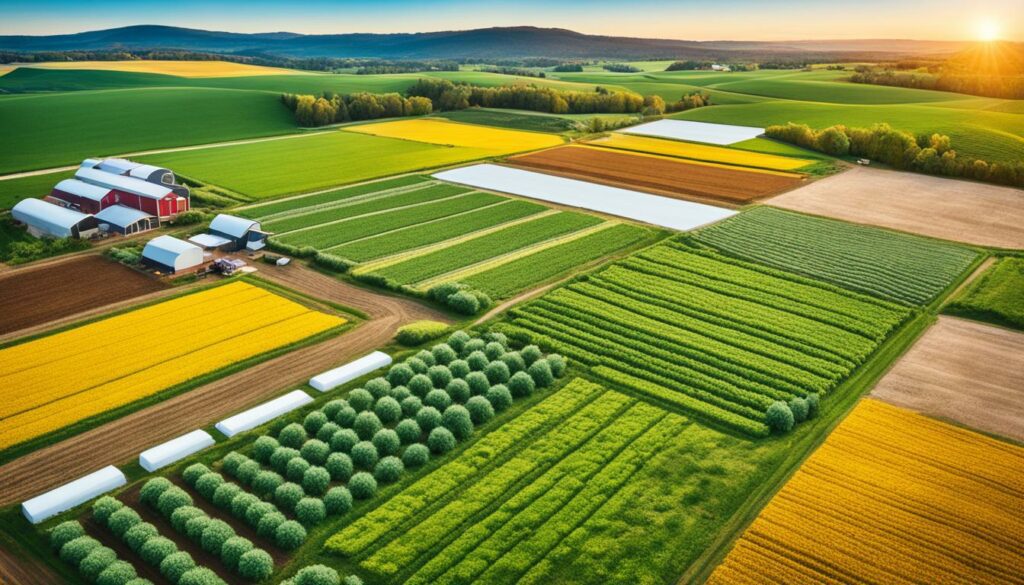
Pinterest is great for reaching women, especially those aged 18-34, as they make up 70% of its users. It’s an ideal place for farms to share pins of their products, seasonal recipes, and farm life. Since almost half of online shoppers buy items they find on Pinterest, it’s a valuable sales tool.
Twitter is about sharing brief updates, like news or quick thoughts. A tweet’s life is around 14 minutes, so farms need to post often to keep followers engaged. With millions of users, it’s perfect for keeping people informed about the farm’s daily happenings, events, and new products. This platform is ideal for quick, ongoing interactions.
To succeed in content marketing, understanding your farm’s audience is key. It’s about knowing your customers well. This means finding out what they like and tailoring your social media content to catch their attention.
Figuring out who’s interested involves looking at details like age, what they buy, their lifestyle, and how they connect with you. Maybe your visitors are chefs after fresh goods, families preferring organic, or enthusiasts of the farm-to-table concept. By putting together a full picture of your audience, you’ll know how to engage them better on social media.
To better understand your audience, use various audience analysis techniques:
Local Line’s Social Media Content service is perfect for farms looking to step up their content marketing. For $399 a month, it offers the creation and sharing of eight posts each month across platforms like Instagram, Facebook, Twitter, LinkedIn, and TikTok. Also, it includes one edit round to make sure the posts match your brand’s style.
With Local Line’s help, businesses get the means to connect with their audience effectively. This can influence their buying choices and help build a vibrant online community.
| Service Features | Details |
|---|---|
| Monthly Fee | $399 |
| Custom Posts | 8 per month |
| Platforms Supported | Instagram, Facebook, Twitter, LinkedIn, TikTok |
| Edits | One round for graphics and copy |
| Annual Discount | 20% off for annual sign-up |
| Asset Ownership | 100% owned by customer |
An effective content marketing strategy matches your farm’s story with what your audience wants. Good audience analysis techniques help create a social media plan that meets customer expectations. This ensures your content stands out for the right reasons.
It’s key to have the right content themes for good social media on farms. Around 68% of US adults are on Facebook, with 66% using it daily. This shows how important it is to have strong themes for engaging content and a solid story for your brand.
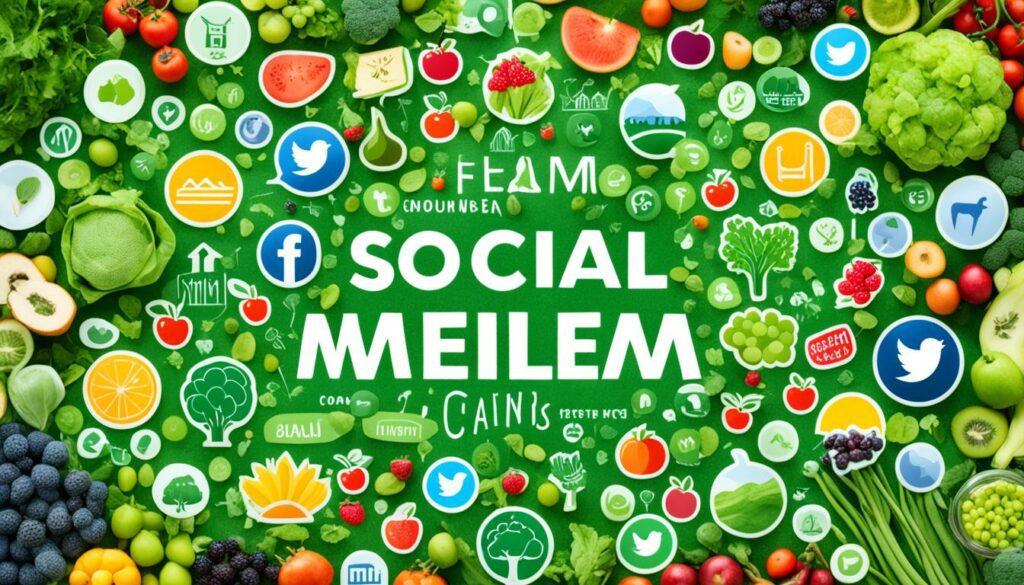
Understanding what your audience likes helps farms tell stories that stick. A big chunk of young adults (millennials), over 90%, are on social media a lot. So, weaving your brand’s stories into things they like, from day-to-day farm activities to going green, can make your brand more likable.
Having a social media calendar makes it easier to handle these themes. Farms posting more than 16 times monthly get 3.5 times more traffic. This means planning what you’ll post ahead avoids flooding but keeps your narrative going.
It’s important to figure out what kind of content clicks with each social media crowd. For example, Instagram is popular with younger, city folks, so eye-catching themes might work best there. On the other hand, Pinterest attracts a mostly female crowd, showing that content like recipes or DIYs could be a hit.
Testing different post frequencies is vital for social media success. But, posting 2-3 times weekly can really boost your brand’s following quality, reach, trust, and loyalty. Tools that help schedule posts and manage platforms save time and keep things on track.
Engaging content is vital for social media success. It captures the attention of your followers. As farming moves online, it’s key to use various content types. This helps your farm connect with people in a meaningful way and keeps it real online.
It’s important to share many kinds of content to keep your social media appealing. Farms can post about educational stuff, show what goes on behind the scenes, and highlight products. Mixing up posts, stories, Instagram Live, and more increases interest. For example, sharing your farm’s morning routine can make people feel closer to you.
Visuals like photos and videos are powerful for social media. They tell your farm’s story better than words. With over 2 billion people on Instagram daily, using the Instagram 5 Method for a consistent look is smart. Highlighting a ‘Product of the Week/Month’ could increase sales. Also, posts from your followers (UGC) and using hashtags like #buylocal can get more people to see your posts.
Telling stories helps you connect with your followers deeply. Share regular updates, personal stories, and celebrate days like National Farmer’s Day. Using captions inspired by the “30 Best Farm Captions for Instagram” can make your posts better. Good stories make your farm more than just a place; it’s a community that people care about.
| Key Points | Details |
|---|---|
| Educational Posts | Informative content about farming techniques and benefits. |
| Behind-the-Scenes | Glimpses of daily farm life to build a personal connection. |
| Product Highlights | Spotlighting individual products to boost sales and interest. |
| Photos and Videos | Strong visual content to captivate and engage audience. |
| Storytelling | Personal stories and updates to foster community and loyalty. |
Keeping a strong online presence means planning ahead is key. With tools designed for social media, we can make content creation easy. This way, posts have a bigger impact.
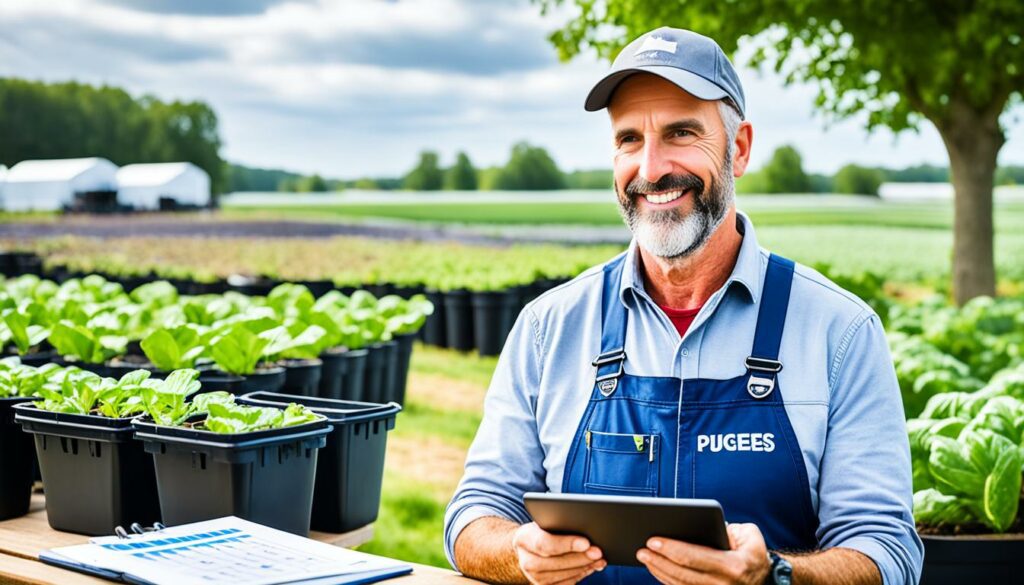
Tools like Later and Asana meet the special needs of social media. They let us schedule posts for sites like Facebook and Instagram. Because many people use Facebook daily, being able to plan posts is essential.
When and how often we post affects how many people see our content. These scheduling tools help us post when our fans are online the most. Even though tweets last for about 14 minutes, posts on Facebook and Instagram can grab attention for much longer.
Since most young adults are on social media, it’s crucial to post often and at the best times.
Social media is a marathon, not a sprint, and the benefits accumulate over time.
A content calendar makes managing posts throughout the year easier. It lets us be more innovative, test new ideas, and avoid mistakes. Planning ahead also helps keep our content up-to-date with seasons and events.
| Platform | Optimal Posting Times | Benefits of Scheduling |
|---|---|---|
| Weekdays, 1-3 PM | 64% of US workforce uses it during breaks | |
| Weekdays, 9-11 AM | High engagement from urban, younger users | |
| Weekends, 8-11 PM | Boosts visually appealing content |
In the end, a solid plan with the right tools helps us serve our audience better. It keeps our posts regular and our engagement high.
Special days and seasonal promotions are great for farms wanting to improve their content marketing. They help create content that people can connect with on social media. This happens by tying in with these well-known calendar events.
National Farmer’s Day on October 12th is a key date for farms. It highlights the hard work of farmers. Farms can share their daily life, creative employee stories, and team contributions. With so many adults in the US on Facebook, marking this day can increase your social media activity and community spirit.
Being creative with seasonal promotions can spark a lot of interest. Sharing recipes with fresh farm produce can really catch people’s eyes. This is especially true on visual platforms like Instagram and Pinterest. Here, autumn recipes with pumpkins or apples can draw in food lovers. Additionally, tips on farming for the season can improve your marketing strategy. It shows you’re knowledgeable about sustainable and seasonal farming, which is valuable.
Take a look at how different platforms can boost your seasonal promotions:
| Platform | Key Demographics | Content Type |
|---|---|---|
| Wide age range, high daily usage | Posts, Photos, Videos | |
| Millennials, urban | Photos, Short Videos, Stories | |
| Females, rural, 18-34 | Infographics, Visuals, Recipes | |
| Males, educated | Quick Updates, Threads, Links |
Using special days like National Farmer’s Day and creating seasonal recipes can boost your farm’s online presence. It not only increases interaction but also strengthens your bond with the community.
Social media management needs constant attention. We must regularly review our content calendar and make changes to our strategy. This ensures our audience enjoys and achieves goals from our posts. Farms need this to stay online and connect with their community. By checking how well our posts do, we learn what works best and on which platform.

Farms may want to focus on Instagram or Facebook to reach young, visually minded adults. On these sites, stylish, high-quality visuals help share the farm’s message. Twitter is good for quick news and chatting directly with people. Pinterest is perfect for showing off farm goods with great pictures. Monitoring shows us which places get the most activity. Then, we can change our strategy to match.
Posting often keeps your followers interested, even if it’s just a few times weekly. Using the right hashtags boosts your posts. It’s good to use popular or timely ones. Talking with your followers, starting conversations, and sharing their posts can make them more loyal.
Working with local influencers and running contests at farmers’ markets boosts your sales and interest. We watch how well these things work and improve our plans using the data. Tools like Later make planning, posting, and checking results easier, thanks to useful features. They support team work too.
Planning your posts in advance helps make them better. You could use Asana for longer-term or a simple spreadsheet for weekly plans. Both have their benefits. And keeping track of what visuals work and what your audience likes helps make your strategy stronger for more engagement.
Linking a content calendar with sales seasons needs careful planning and a strong sales plan. Aligning storytelling and promotions makes every post valuable. It warms up the audience and makes them look forward to sales. This part talks about how to mix these aspects well for the best results.
Getting ready is key when joining a content plan with sales times. Start by picking out the important sales times and match them with content topics. This helps carry out a detailed sales plan. It uses stories and keeps sales strong.
Let’s say, a new product is launching next month. My posts in the weeks before would tell stories about it. This could be sneak peeks into making the product or reviews. This sets up a story that holds the audience and gets them ready for sales.
Posting often is very important. More than 70% of grown-ups use social media now. And they only pay attention for about 8.5 seconds. Regular, interesting posts are key. They keep your brand in mind and build a connection with your audience.
Platforms like Instagram and Facebook offer lots of ways to engage users. Things like tagging and analytics can really help. Using these with a content plan can push up your sales.
Here are some tips for regular posting:
Companies that tie their content plan with their sales report better success. And those who write down their tactics are a lot more likely to do well. So, it’s really key to post regularly. This keeps people interested and helps sales grow.
In today’s digital world, using analytics is key to better social media interaction. By looking closely at social media insights, farms can make specific plans that people understand. Knowing the age, likes and how people act online is the core of good content optimisation. This makes sure every post has a clear goal.
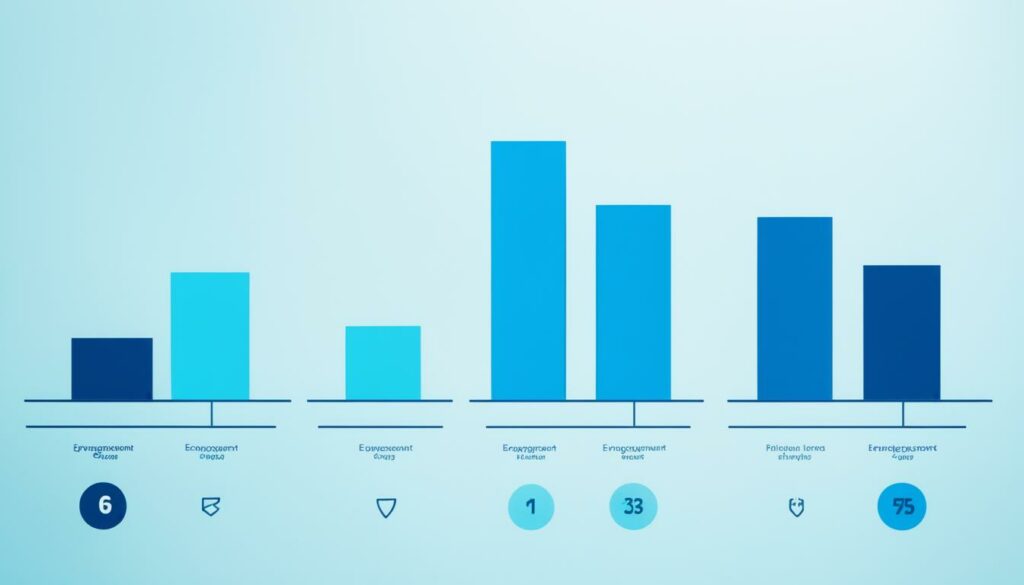
Talking to your audience is a big part of doing well on social media. Respond to their messages and comments. Not only does this show you care, but it also makes them more loyal. Sharing photos and interesting stories about farm life really catches people’s eyes. It’s a great way to get a strong message across too.
“The brain can process images in as little as 13 milliseconds,” highlight researchers from MIT, underscoring the importance of visual content in social media.
Working with influencers can also boost your social media game. Find some local influencers, see who follows them, and connect with them in a way that’s true and both sides can benefit. Also, having contests with good prizes and making the rules clear can really get people involved. This is great for creating buzz and selling more at farmers’ markets.
To make sure your social media work is paying off, it’s important to have clear goals. Keep an eye on who’s seeing your posts and engaging with them. Checking how you’re doing helps you adjust your plans to stay on target.
| Factor | Impact |
|---|---|
| Platform Popularity | Influences reach and audience engagement |
| Post Consistency | Maintains audience interest and anticipation |
| Hashtag Effectiveness | Boosts visibility and expands reach |
With more than 70% of grown-ups using social media today, it’s more important than ever to use analytics well. By using these tools, farms can come closer to their community online. This leads to stronger and longer-lasting ties with their audience.
A content calendar for social media is key for farm marketing. It ensures posts are timely and well-planned. This helps farms keep their community engagement high and boosts sales complements.
It’s important for farms to mix stories that align with their sales goals. For example, many adults in the US use Facebook daily. It’s a great place for stories that grab attention and lead to sales. This also works well on Instagram, where many US adults also hang out.
Stories creatively made can catch the eye of buyers and touch the community’s heart. Sharing bits of farm life, the latest produce, and sneak peeks keep people interested. Videos on YouTube, shared on other platforms, can get more eyes on your farm and what you sell.
Connecting with the community is crucial for trust and loyalty. More than 90% of millennials use social media. Teaching and having fun with them through posts is a win. Pinterest, where women are often found, is perfect to share unique farm stories. Twitter can be used for quick updates and to share interesting news, showing your farm is active and reliable.
Using a content calendar social media farms approach assures posts are not only about sales. They also share valuable and fun content with the community. Tools like Hootsuite and Google Calendar help plan smarter. This leads to better posts, making the farm more engaging and boosting sales.
In today’s world, social media is a big part of life. For farms, having a solid content plan is vital. It helps line up your posts with what you want to achieve. This way, you reach your goals while staying connected with your followers.
On sites like Instagram and Facebook, farms can share their stories. People, especially young adults, love seeing pictures and videos. This is a great way for farms to show off their products and tales.
Sharing stories and making videos can keep customers coming back. It’s not just about showing up online. Using the right tags and posting regularly helps people see your posts. Plus, talking with your followers in the comments makes them feel valued.
Showing off your farm through visuals is super important. It catches people’s eyes and gets your message across.
Working with influencers can help too. They can make your farm seem more trusted in the farming world. Hold contests to get people really involved. Watching how your posts do can tell you what’s working. This lets you make smart moves based on real data.
With a well-thought-out social media plan, farms can do well online. It’s all about engaging people, keeping up with them, and having a clear plan. This helps farms not just make money but also build a strong, supportive community.
A marketing calendar is like a planting guide. It helps farms have harvests at set times for sales. It also plans how to use social media to talk to their community. This means not just talking about sales but telling interesting stories too.
By sharing stories and helpful content regularly, farms make friends with their online fans. These friendly talks make selling things later easier. It also makes the farm more well-known and loved.
A content calendar is a detailed plan. It says when to post, what to talk about, and where to post online. This keeps the farm always online, talking in ways that people like.
To make a content calendar, first, know when people are ready to buy. Then, write about things that match the buying times. Use a template to help organise what to say and when.
Facebook and Instagram are great for showing stories with pictures. Pinterest works well for pretty products. Twitter is best for fast news. Pick the ones that fit what you want to say and the people you want to say it to.
To understand your customers, learn what they like and do, online and off. Knowing this helps you talk to them better online. This makes sure what you share is interesting to them.
Find big topics that tell your story and stick to them. This makes everything you say online make sense and be interesting. It’ll help people remember you too.
Teach with your posts, show what’s going on behind the scenes, or talk about your products. Use lots of pictures and videos. They bring your farm to life for people reading online.
Scheduling posts keeps you talking to customers when it matters. This means they hear from you when they’re most likely to pay attention. It helps keep people interested in what you have to say.
Share special days and recipes to keep things fun and interesting. This makes what you say more connected to how people are already thinking. It helps show you know what they like.
Looking at what works helps you talk to people better. It makes sure what you say stays good and interesting. This way, people keep wanting to hear from you.
By mixing sharing stories with talks about buying things, you prepare customers earlier. This makes people more excited to buy. It also keeps them happy to hear from you.
Analytics tell you what people like and do online. Use this to make your social media talk better to them. It helps make more friends and fans of your farm.
A good content plan mixes stories with details about buying. This makes you a friend of your online community. It helps grow your group of supporters and your sales.